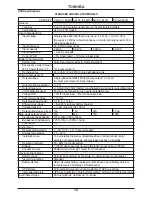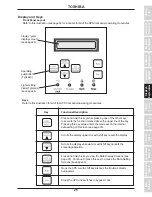
28
TOSHIBA
Data Display Screens
The 'Data Display Screens' sequentially displays all normal UPS operating data display screens as
the 'down' arrow key is pressed. The 'up' arrow can also be pressed at any time to back up to the
previous screen. These 'Data Display Screens' are accessed from the last 'UPS Start-up Screen' :
Display Screens (cont'd)
INPUT VOLTAGE
###V
INPUT FREQUENCY
##.#Hz
OUTPUT VOLTAGE
###V/###V/###V
OUTPUT CURRENT
##%/##%
BAT INSTALL DATE
11/04/1998
BATTERY VOLTAGE
##%
OUTPUT FREQUENCY
##.#Hz
BATTERY LIFE
REMAIN 3.5YR
INTERNAL TEMP
## C
TIMER STOP DATA
TO VIEW:SELECT
CAL OPER MODE
DISABLE
WEEKLY SCHEDULE
TO VIEW:SELECT
SPECIAL OPERATE
TO VIEW:SELECT
SPECIAL OFF TIME
TO VIEW:SELECT
11/04/1998
10:45
TIMER START DATA
TO VIEW:SELECT
1) If the
key is pressed from any of the Data
Display Screens then the display will advance to
the Data Setting Screens. (See page 30)
2) Displays L-L input voltage (when an isolation
transfprmer is used, the unit senses input voltage
from the secondary side and there may be
a +/- 3 volt difference between the display reading
and the actual input voltage).
3) Displays L-N (U-phase)/L-N (V-phase)/L-L output
voltages.
4) Displays the U-phase and V-phase current as a
% of maximum load capacity at a 0.7 lagging P.F.
5) Displays the battery charge voltage as a % of
the rated nominal DC voltage of the batteries.
6) Date and Time setting
7) If the
key is pressed from any one of
the Timer Start Data, Timer Stop Data, Weekly
Schedule, Special Operate, and Special Off time
screens then special 'Data Display Screens are
viewed. These functions can only be changed by
serial communication interface.(See page 29).
See notes 1, 2
Shift
Select
Set
Monitor
See notes 1
See notes 1, 3
See notes 1
See notes 1, 4
See notes 1, 5
See notes 1
See notes 1
See notes 1
See notes 1, 6
See notes 1, 7
See notes 1, 7
See notes 1
See notes 1, 7
See notes 1, 7
See notes 1, 7
Notes:






























